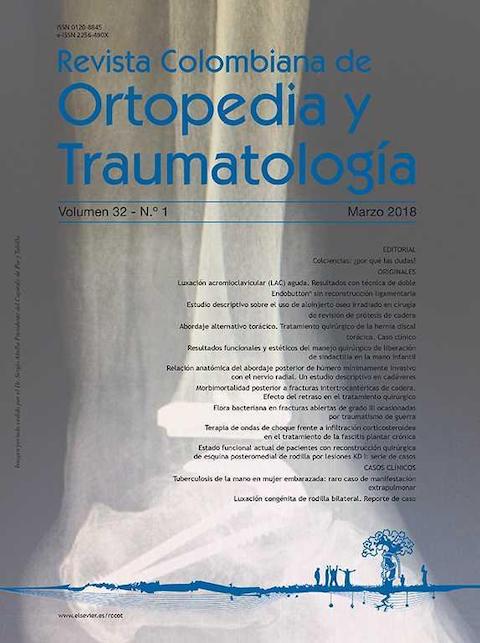Bacterial flora in grade III open fractures produced by war injuries
DOI:
https://doi.org/10.1016/j.rccot.2017.07.006Keywords:
open fracture, grade III, war wound, antibiotic prophylaxis, antibiotic therapyAbstract
Background: War injuries such as those produced by modified antipersonnel mines generate extensive soft tissue damage and traumatic amputations, which are severely contaminated with soil, vegetation, faecal components, and even the tissues of other victims. The objective of the study is to establish the type of microorganisms that are isolated in these types of injuries.
Materials and methods: A case series was conducted between January 2012 and December 2014, which included all patients with wounds from gunshots, fragmentation weapons, or antipersonnel mines, who had bone-tissue involvement, bacteriological cultures of bone and / or soft tissues with definitive reports, and antibiotic sensitivity tests on isolated germs.
Results: Of the126 patients included, it was found that 72% had an open fracture grade IIIA, and 28% a grade IIIB fracture. Gram negative bacteria were the most isolated in cultures (41%). Enterococcus faecalis was the most frequently isolated bacterium (15%), followed by Pseudomonas aeruginosa (13%).
Discussion: It was shown that 52% of isolated germs had some type of resistance to the empirical antibiotic management that was applied as a protocol at the time of admission (cephalosporin + aminoglycoside and ciprofloxacin + clindamycin in case of fragmentation weapons). This sets a new medical and surgical challenge for all those responsible for the integral management of these kinds of patients.
Evidence level: III.
Downloads
References
Suárez F, Satizábal C, Calderón O, Ramírez V, García A, Náquira LF. Flora bacteriana en heridas de guerra. Experiencia de dos años en el Hospital Militar Central de Bogotá. Rev Med. 2008;16:127-33.
Fries CA. Prospective randomized controlled trial of nanocrystalline silver dressin versus plain gauze as the initial postdebridement management of military wounds on wound microbiology and healing. Injury. 2014;45:1111-6. https://doi.org/10.1016/j.injury.2013.12.005
Hansraj KK, Weaver LD, Todd AO, Taylor SM, Griffin MD, Dukhram KM, et al. Efficacy of Ceftriax- one versus Cefazolin in the prophylactic management of extra-articular cortical violation of bone due to low-velocity gunshot wounds. Orthop Clin North Am. 1995;26:9-17. https://doi.org/10.1016/S0030-5898(20)31963-5
Ordog GJ, Balasubramaniam S, Wasserberger J. Outpatient management of 357 gunshot wounds to the chest. J Trauma. 1983;28:832-5. https://doi.org/10.1097/00005373-198309000-00008
Knapp TP, Patzakis MJ, Lee J, Seipel PR, Abdollahi K, Reisch RB. Comparison of intravenous and oral antibiotic therapy in the treatment of fractures caused by low-velocity gunshots. J Bone Joint Surg. 1996;78-A:1167-71. https://doi.org/10.2106/00004623-199608000-00006
Bartlett CS, Helfet DL, Hausman MR, Strauss E. Ballistics and gunshot wounds: effects on musculoskeletal tissues. J Am Acad Orthop Surg. 2000;8:21-36. https://doi.org/10.5435/00124635-200001000-00003
Court-Brown CM, McQueen MM, Quaba AA, editores. Management of open fractures. London: Martin Dunitz; 1996.
Court-Brown CM, Rimmer S, Prakash U, McQueen MM. The epidemiology open long bone fractures. Injury. 1998;29:529-34. https://doi.org/10.1016/S0020-1383(98)00125-9
London, P.S.,London PS. Medical lessons from the Falkland Islands' campaign. Report of a meeting of the United Services Section of the Royal Society of Medicine held at the Royal College of Surgeons on February 17 and 18, 1983. J Bone Joint Surg Br. 1983;65:507-10. https://doi.org/10.1302/0301-620X.65B4.6874724
Jackson DS, Batty CG, Ryan JM, McGregor WS. The Falklands War: Army field surgical experience. Ann R Coll Surg Engl. 1983;65:281-5.
Ryan JM, Cooper GJ, Haywood IR, Milner SM. Field surgery on a future conventional battlefield: strategy and wound management. Ann R Coll Surg Engl. 1991;73:13-20.
Batinica J, Batinica S. War wounds in the Sibenik area during the 1991-1992 war against Croatia. Mil Med. 1995;160:124-8. https://doi.org/10.1093/milmed/160.3.124
Burkle FMJM, Newland C, Meister SJ, Blood CG. Emergency medicine in the Persian Gulf War-Part 3: Battlefield casualties. Ann Emerg Med. 1994;23:755-60. https://doi.org/10.1016/S0196-0644(94)70311-6
Mehran R, Connelly P, Boucher P, Cote M. Modern war surgery: the experience of Bosnia. 2: the clinical experience. Can J Surg. 1995;38:338-46.
Uhorchak JM, Arciero RA. Recent wounds of war: lessons learned and relearned. Tech Orthop. 1995;10:176-88. https://doi.org/10.1097/00013611-199501030-00007
Covey DC. Blast and fragment injuries of the musculoskeletal system. J Bone Joint Surg Am. 2002;84:1221-34. https://doi.org/10.2106/00004623-200207000-00022
Anderson JT, Gustilo RB. Immediate internal fixation in open fractures. Orthop Clin North Am. 1980;11:569-78. https://doi.org/10.1016/S0030-5898(20)31458-9
Barach E. Ballistics: a pathophysiologic examination of the wounding mechanisms of firearms. Part II. J Trauma. 1986;26:374-83. https://doi.org/10.1097/00005373-198604000-00012
Brettler D. Conservative treatment of low velocity gunshot wounds. Clin Orthop. 1979;140:26-31. https://doi.org/10.1097/00003086-197905000-00006
Davis GL. Management of open wounds of joints during the Vietnam war. Clin Orthop. 1970;68:3-9. https://doi.org/10.1097/00003086-197001000-00002
DeMuth WE, Smith JM. High velocity bullet wounds of muscle and bone: the basis of rational early treatment. J Trauma. 1966;6:744-55. https://doi.org/10.1097/00005373-196611000-00006
Downloads
Published
How to Cite
Issue
Section
License
Copyright (c) 2024 Revista Colombiana de ortopedia y traumatología

This work is licensed under a Creative Commons Attribution 3.0 Unported License.




